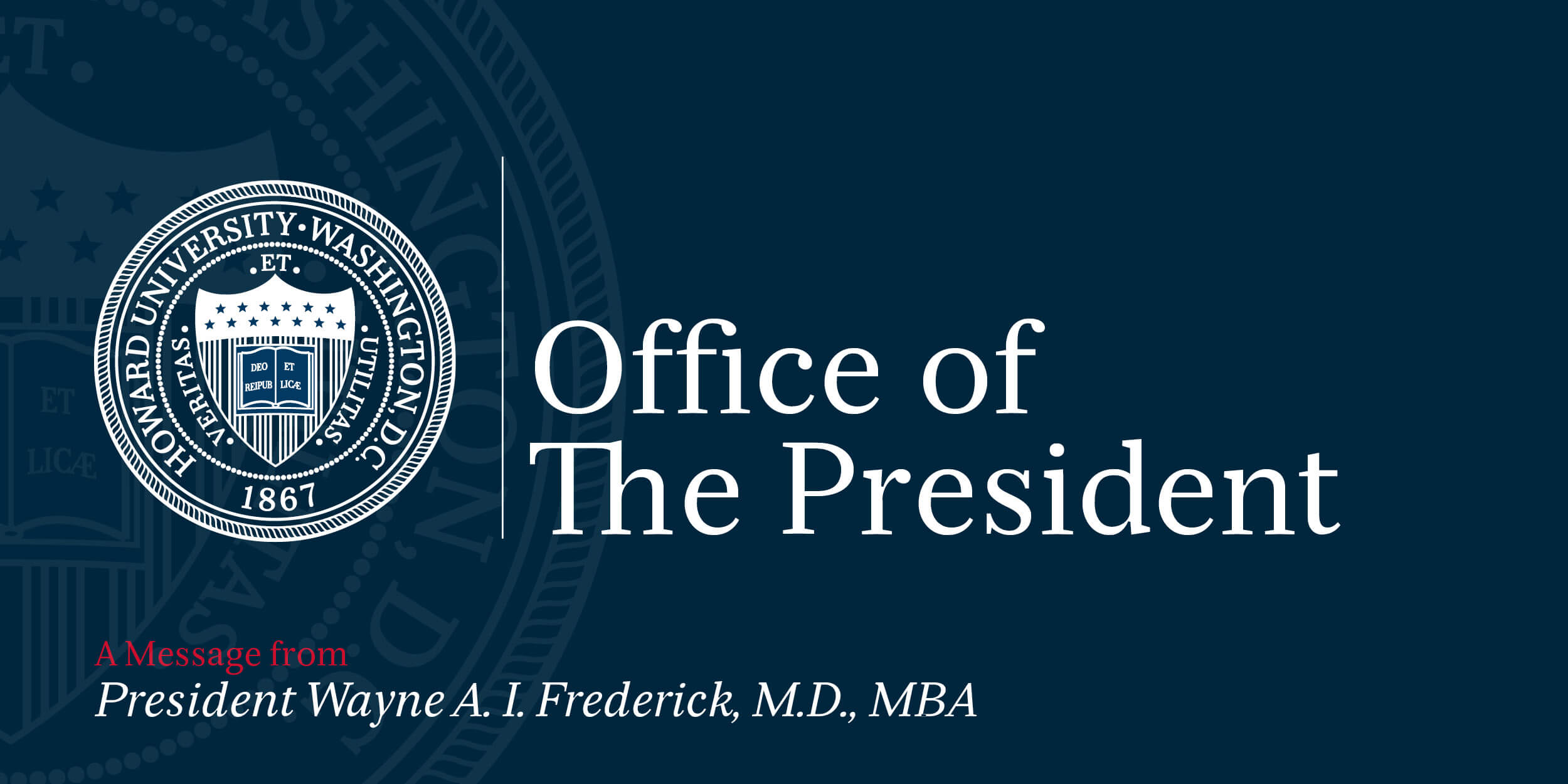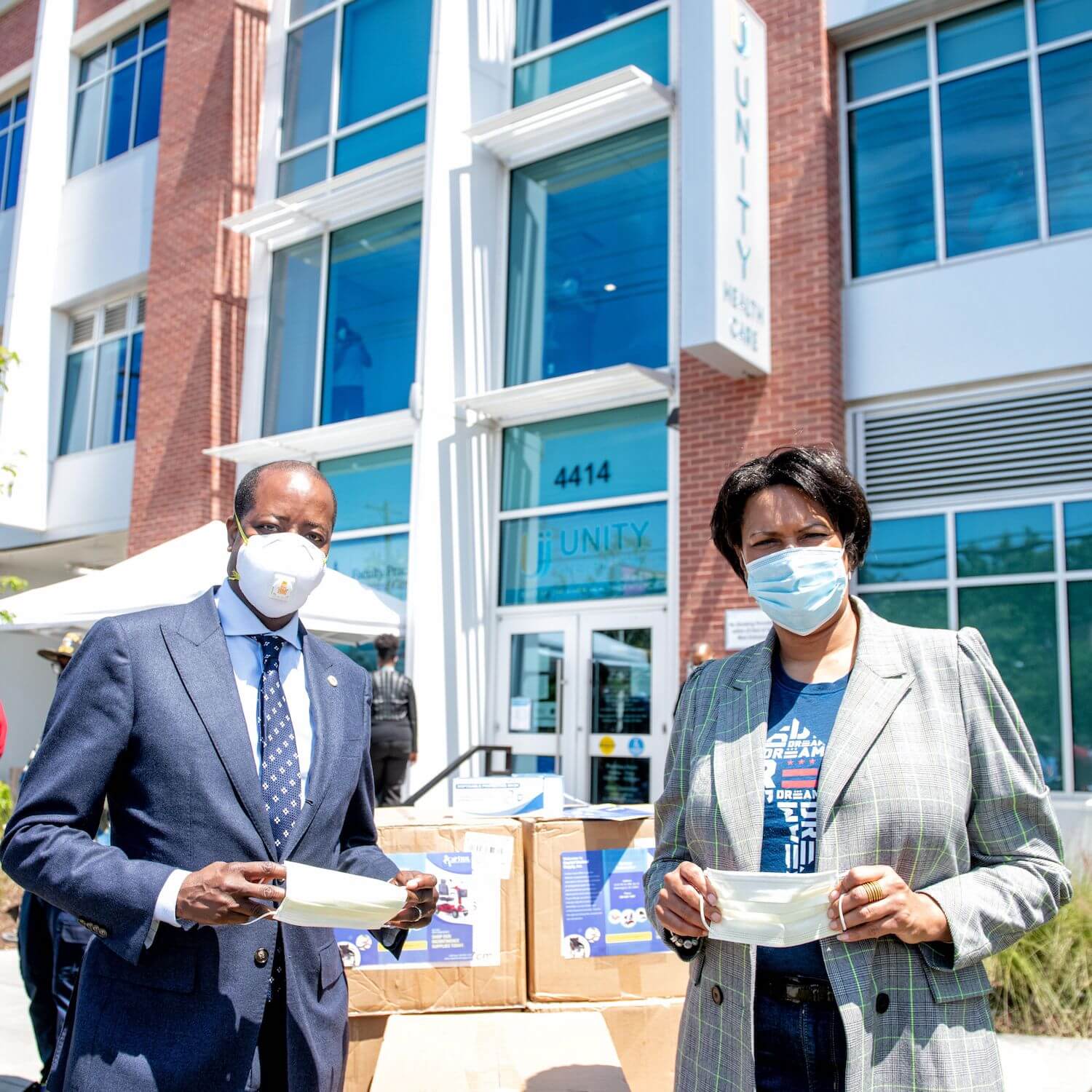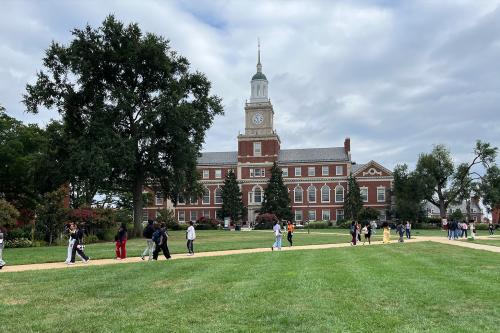
Dear Howard University Community,
Thank you for your patience and support as we have worked through the development of a comprehensive plan for the Fall 2020 semester. Howard University continues to monitor the COVID-19 pandemic and has already started to implement the necessary actions to mitigate risks associated with the COVID-19 pandemic, while maintaining services required to deliver an exceptional education to our students and conduct critical research on campus.
The University’s Fall 2020 Re-opening Plan is the product of broad discussions and recommendations from the President’s Re-opening Taskforce, as well as the members of the 13 Fall 2020 preparation sub-committees, with representation from over 150 students, faculty, staff, local community leaders, and in accordance with guidance from the Centers for Disease Control and Prevention (CDC), local and federal government.
I am pleading with you to be understanding, patient and flexible. The future has a myriad of unknowns that makes static decision making nearly impossible. We will do all we can to make changes quickly and with prudence.
The Fall 2020 re-opening guidance, available at this link, was framed around the following tenets:
- Howard University will make decisions guided primarily by considerations for the health and safety of our students, faculty, staff and surrounding community.
- Decisions about health and safety made by the University in the context of COVID-19 will be evidence-based and data-driven, where data is available.
- Howard University will continue to deliver an exceptional education and optimal services, within the unavoidable constraints of the COVID-19 response.
- Howard University will be transparent when communicating to our entire University body and our community.
It is critical that you read the Fall re-opening guidance document and familiarize yourself with its contents.
We are planning for a hybrid academic model where some students and faculty will be in the classroom and others will be online. The decision on which students and faculty meet face to face will be made based on health risk to faculty, staff and students regarding underlying medical conditions or concerns over transmission, academic discipline and course content, as well as degree attainment and accreditation requirements. Students and faculty have been surveyed on their preference to meet for classes face to face or fully remote, and the University is doing its utmost best to accommodate all students’ needs.
We understand that some members of the Howard University community will not be comfortable engaging in face to face instruction or a residential campus environment this Fall due to underlying medical conditions or a concern over transmission to friends or family members. To the extent possible, deans and chairs will discuss with faculty and provide flexibility regarding course instructional format, and teaching responsibilities. Staff supervisors will meet with staff to provide flexibility regarding work options, whenever possible. Academic advisors will consult with students to design plans to maximize learning opportunities. Students who prefer to enroll only in fully online courses may do so, but may not necessarily have access to the same courses included in their original plans of study, in the event that these courses are in-person, or a blend of in-person and online. Although we plan to offer a significant number of classes fully online, not all courses may have a remote option, particularly some laboratory, clinical, and performance-based courses. Additional details regarding course offerings will be provided by July 15, 2020.
We are also aware of the unique responsibility of Howard University from our mission to provide “an educational experience of exceptional quality at the undergraduate, graduate, and professional levels to students of high academic standing and potential, with emphasis on educational opportunities for Black students.” A recent survey of returning students highlighted student preferences with regards to offering both online and face to face choices.
 The University will provide personal protective equipment (PPE) in the form of masks or face coverings and sanitizing agents to all faculty, staff and students as part of a Howard University Care Package. Additional PPE will be provided as appropriate, particularly to our health professional students, faculty and staff.
The University will provide personal protective equipment (PPE) in the form of masks or face coverings and sanitizing agents to all faculty, staff and students as part of a Howard University Care Package. Additional PPE will be provided as appropriate, particularly to our health professional students, faculty and staff.
Howard University will be physically re-opening in phases. Critically essential personnel never left the campus and have always had access to the physical campus. A small number of essential personnel will start returning to campus on July 1, 2020, pending approval of this plan by the District of Columbia government; the declaration that the District is in Phase 2 of re-opening; and that testing, sanitation, and social distancing guidelines have been developed for workspaces. We will use the first stage of opening to determine the University’s readiness for limited expansion of staffing. Expanded staffing will be tightly controlled and coordinated to mitigate potential risks, considering the safety of faculty and staff, as well as the communities we serve. No unit or department should increase staffing levels beyond current needs to support essential on-site operations without approval from your respective supervisor. Once decisions to expand on-site staffing in certain areas have been made, staff should follow the policies and protocols detailed in this guide for returning to work on campus. Pending readiness, the plan is that other personnel will return in phases. Dates will be shared with the campus community once assessment and readiness is complete. The District’s Phase 2 of re-opening limits the staffing of any office building to 25% of normal capacity. Supervisors will work with staff to determine workforce return that may include a combination of remote work, alternating days and staggered reporting/departing.
The University is making accommodations for faculty, staff, and students who are in high-risk groups, to teach, work and attend classes and, where feasible, work remotely. Following CDC guidance, these groups may include, but are not limited to individuals with: chronic lung disease, moderate to severe asthma, serious health conditions, immunocompromised conditions, severe obesity, diabetes, chronic kidney disease and liver disease, and those who are over the age of 65.
The first day of classes for undergraduate students, and many graduate/professional programs will take place on Monday, August 24, 2020. Professional schools will continue to implement their calendars consistent with accreditation and specific programmatic guidance. Details regarding move-in dates will be shared with our students.
In accordance with CDC guidance, Howard University will require that all members of the University community and any limited visitors employ the following social distancing guidelines:
- Keep at least six feet between yourself and another person in all public places and inside all buildings.
- Avoid close contact with others.
- Face masks or face coverings must be worn by everyone on campus when in the presence of others and in public settings where other social distancing measures are difficult to maintain (e.g., common workspaces, meeting rooms, classrooms, etc.). Remain at home, or in a dormitory room, if you have a fever, or other symptoms associated with COVID-19.
- As part of DC’s phased guidance, the University will operate at 25% building capacity in office spaces, until local guidance dictates otherwise.
- Training for faculty, staff and students will be conducted, including required student participation in an online educational seminar, prior to the start of the fall semester, designed to inform students about the health behaviors expected and required during the fall semester. Training for faculty and staff will also be provided including educational material regarding the risks associated with COVID-19 and proper methods to mitigate said risks. Materials will also include symptom screening and testing, and where to receive treatment as needed.
Testing, Screening and Contact Tracing
- Students are required to complete a COVID-19 test within the seven days prior to arriving on campus, then share results with the Student Health Center. Screening for COVID-19 will be conducted for the entire student population at the start of the semester and an ongoing regimen of regular screening of students, faculty and staff throughout the fall semester will be implemented. All faculty and staff will be required to participate in a baseline COVID-19 test within seven days of return to campus, or at an official COVID-19 testing site.
- The University will require regular (daily) symptom screening for all students and staff. This may be conducted through mobile phone app (to be provided) or via questionnaire.
- We will be coordinating contact tracing with the Department of Health for any suspected cases of COVID-19 among faculty, students and staff on campus.
- Isolation spaces have been identified on our campus, in the event it is needed.
- Plan A - large residential apartment space has been identified to quarantine and isolate students as needed.
- Plan B - Should the number of students who need to isolate increase; the isolation area will be expanded. If there is an exceptional isolation need, a wing at Howard University Hospital will be used for this purpose.
Mental and Emotional Well-being
Health services are available through primary care providers, especially to provide emotional support during this period of heightened anxiety. Telephonic or video counseling is available, and you can access this service using most smartphones, tablets and computers with a camera. Employees should contact the Office of Human Resources to learn more about available support, while students may contact the University Counseling Service for remote support, even during Summer months.
Please utilize Howard University’s web resources to learn more about support services, managing stress and enhancing individual resilience during this time.
Academic Calendar
- On-campus undergraduate courses will begin on August 24, 2020, and continue through November 24, 2020. Students will return home for Thanksgiving and not return to campus until the start of the Spring term. The final examination period may be scheduled prior to or after Thanksgiving. If the final exam period is scheduled after Thanksgiving, then the exams will be provided online. Further guidance will be provided appropriately.
The guidance below regarding classroom management and scheduling is primarily specific to our undergraduate programs. Due to accreditation and other program specific requirements, graduate and professional programs may have differences in their academic calendars, clinical requirements and expectations, and course options.
Classroom Management
- The University is planning for a hybrid academic model with face to face and online course offerings.
- Based on current CDC guidelines, and the classroom space available on campus, the anticipation is that the majority of courses will be taken online in a synchronous or asynchronous (e.g. recorded) method, with allowance for in-person instruction, in particular for labs, clinicals, performances and internships. This format may be modified, should guidelines be changed over the Summer and into the Fall, or if the local conditions change.
- The capacity of all classrooms will be restricted to 20%-30% of the design capacity to allow for social distancing, prioritizing larger lecture halls and auditoriums for use with the largest classes that require face to face (F2F) instruction. Capacities for some smaller classroom spaces may be further reduced to implement social distancing.
- If a student prefers not to return to campus in the Fall, for whatever reason, they have the option to continue academic progress towards a degree online, to the extent that desired courses are available online.
- Courses with large enrollment (over 30 students) will be taught online, with few exceptions.
- In some professional programs, accreditation and licensure considerations may constrain our ability to fully continue instruction in an uninterrupted manner, especially where clinical instruction is a requirement. Howard University will make every effort to inform students of any regulatory restrictions that will impact degree completion.
Events and Gatherings
- In accordance with CDC and District guidelines, no large gatherings will be allowed, especially within confined spaces. The capacity of gatherings will be guided by social distancing restrictions current at the time. Event organizers should anticipate conducting mostly virtual events. Details on athletic and celebratory events can be found on the Fall re-opening website.
Residence Life
- Students will be assigned to a combination of single and double rooms. No triples or quads will be available. The plan is to de-densify residence halls to maximize social distancing and protect student health.
- Students will sign up for a move-in registration time, with options spread out over several days to keep the population density low. Further details will be provided by the Division of Student Affairs.
Research
Research at Howard University will be categorized under four Priority Classifications (PC) and launched through three re-opening phases. Consistent with the re-opening classification method of the District of Columbia, we are currently in Phase I of the Research Re-opening Plan, to stabilize essential research operations. As the District moves into Phase 2 of re-opening, the University will also move to expand essential research operations and creative activities. Faculty researchers and student researchers will be required to complete a COVID-19 training course to further prepare for re-establishment of research activities. Researchers should make detailed plans for regular monitoring of the implementation of prevention strategies (e.g. handwashing, PPE, etc.) by their research staff and students, and describe prompt corrective measures for staff that are not in compliance. The success of this entire mitigation process institution-wide is heavily dependent on strict compliance at the unit level. Additional details regarding the research plan will be provided by the Office of the Vice President for Research.
Dining
- Dining services will provide enhanced take-away service and delivery options, while self-serve buffet-style meals will not be possible.
- Additional outdoor seating options will be provided.
- An optional reservation system will be put in place to take pre-orders.
Communication Plan
The University will implement a communication plan with the following objectives:
- to advise students returning for the fall semester to obtain a COVID-19 test within one week of arriving on campus and to bring the results of that test with them.
- to educate students and the rest of the University community about infection prevention and control measures, the symptoms of the virus and what to do if they are symptomatic, specifically, the need to stay at home.
- to self-isolate if they have symptoms or have come into close contact with infected persons and to quarantine if infected themselves.
- to disseminate information about the availability of healthcare resources, mental and physical health promotion, and where to find local public health information about COVID and updated CDC and District of Columbia guidance.
I want to thank our incredibly committed faculty, staff and students who have worked assiduously to develop the details of the plan with a focus on the safety and health of our community. The District of Columbia must approve the University’s Fall Re-opening Plan before it can be implemented. If the District requests modifications or additions to the plan, we will update the University community via the Fall re-opening website. We will do our best to communicate changes swiftly, so that you and your families can make appropriate plans for the upcoming year.
This continues to be one of the most challenging years in the history of the University, but I am encouraged by the dedication that I have witnessed to maintaining the Howard University experience, providing the high quality education that our students deserve, and an environment conducive to high quality research, following CDC guidance, in as safe a manner as possible. We are an essential institution to our community. During the pandemic we stepped up and assisted our community in many ways. We expanded our hospital capacity, stood up free testing sites, supported a multidisciplinary research group to the pandemic, and participated with community leaders in the Black Coalition against COVID-19. During this pandemic many African Americans in our community have not been able to access healthcare and social services. This will result in more advanced disease processes and more social ills. I have already seen this personally as I have been operating on patients with advanced cancers as recently as last week. As we return we must be mindful that our community needs us now more than ever.
Our collective commitment and responsibility to each other are key to our success. We must adhere to guidelines when we are away from campus and when we are on campus. We employ more African American faculty than any other higher education institution in the world and we produce more African American graduates in many fields of study as well. Our responsibility to protect our community is a sacred one and begins with our personal behavior given the disproportionate outcomes of African Americans who contract COVID-19. Please continue to be safe and I look forward to interacting with many of you again soon, as the guidance from our health experts evolves in accordance with local conditions.
Excellence in Truth and Service,
Wayne A. I. Frederick, M.D., MBA
President




